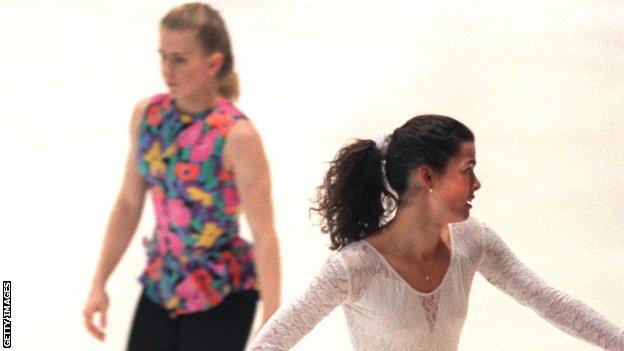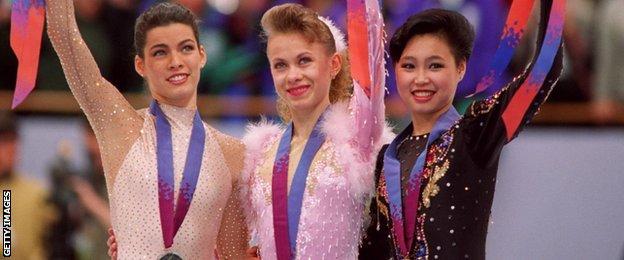Tonya Harding in Olypics Agains Nancy Carrigan in Polymics

It was a blackness-and-white story for a glitzy sport in a gaudy era: Tonya Harding the villain, Nancy Kerrigan the victim, Olympic effigy skating mixed with whodunnit and farce and tragedy, a vast global audience relishing each macabre twist and turn.
Harding was ever portrayed as the stonewashed-denim bad girl from the wrong side of the rink, Kerrigan the make clean-cut kid with the wholesome backstory. 1 skated to heavy metal and danced in home-fabricated costumes. The other did Campbell's soup commercials.
Had their rivalry stayed on the water ice, you might never have heard of them. But in the build-upwards to the 1994 Winter Olympics in Lillehammer, preparing for the U.s.a. National Championships, Kerrigan was attacked every bit she finished training. Harding's ex-married man and her bodyguard had hired a third human being to interruption her leg, hoping to ruin her Olympic hopes and thus dramatically boost Harding's.
In Fargoesque fashion, it went wrong. The aggressor, a man named Shane Stant, initially failed to recognise Kerrigan, having to ask a spectator to signal her out. When he did strike her, with a scope baton, he missed her knee and managed simply to inflict a bad bruise. Attempting to make a stealth escape, he panicked and then badly he decided to headbutt his manner through a glass fire-escape door.
Kerrigan - famously filmed in the immediate backwash repeatedly wailing the give-and-take "why?" - recovered apace plenty to make Olympic pick. Harding won the nationals and went to Lillehammer too, accompanied - as a issue - by a media and moral frenzy that would threaten to sweep both abroad.
Those are the facts. What the film attempts to reassess is our reaction to them: how much Harding knew of the plot, how much she was to blame; if she ever stood a take a chance, as a bluish-collar girl wearing skimpy pink chiffon; whether information technology was really her, after a babyhood and union steeped in alleged abuse, who was the victim every bit much as Kerrigan e'er could be.
"At that place'south no such thing as truth," says Harding, played with foul-mouthed enjoy past Margot Robbie, at one bespeak. Which might seem rather 2018 for a drama set 24 years ago, but reflects likewise the alien stories told by Harding, her then husband Jeff Gillooly, bodyguard Shawn Eckhardt and Harding's mother LaVona.
Gillooly spent fourth dimension in prison for his part in the crime. So as well did Stant, Eckhardt, and Stant's getaway driver Derrick Smith. Harding pleaded guilty to hindering the prosecution, which meant she admitted she knew the identity of those behind the set on, simply not until after it happened. For that she received 3 years' probation, a $100,000 fine and 500 hours of community service.
Speculation filled the gaps and much more than besides. Surely Harding knew more about information technology, went the cynical line. And that was how she was treated at those Olympics: as not just an unwitting cohort, but as an instigator too.

There would be no happy catastrophe in Norway. Harding, struggling with a broken lace on her boot, finished that Olympic final in eighth. Kerrigan went meliorate with silver but looked equally happy with that as with a fall, Oksana Baiul from Ukraine sneaking up unseen on the rails for gold.
In the backwash, Harding was banned for life past the Us Figure Skating Association. At the time that seemed draconian; the moving picture suggests information technology may have had as much to do with her groundwork and paradigm every bit the alleged crime.
Rewatching that Olympic final brings other subtleties back the fore. It is easy to forget what a bang-up skater Harding was, athletic where Kerrigan was adroit, the first American adult female to land a triple Axel in contest.
If her aesthetic is unproblematic - a maroon outfit for the free skate in Lillehammer to Kerrigan's puritan white, a vocal from Jurassic Park her soundtrack - her operation is all speed and height and spins.
Picture show and idiot box often struggle to accurately capture either the physicality of sport or its capacity for impossible plots; fiction takes yous to a prepare resolution, sport can accept you anywhere. I, Tonya reminds you of both.
And then at that place is the scene with Harding in the toilet just before that showdown, alternating between tears and an atrocious stock-still grin, her heavy make-upwards both warpaint and an inadvertent nod to her status as pantomime villain. In that moment you get an acute sense of the pressures an Olympic terminal creates, of the frequently-described feeling of spending your whole life working towards this moment, yet when information technology arrives being desperate for it to laissez passer.
Harding is held upwardly to exemplify another darker chemical element of the Olympic dream: the lengths obsessive athletes will go to when they're put under force per unit area. The movie makes it clear she is an unreliable witness. It also tries to explicate why.
"People tell themselves what they demand to tell themselves in order to be able to live with themselves," screenwriter Steven Rogers told BBC Sport.
"Everybody has their own truth. Jeff says he never striking Tonya, yet there are constabulary reports. Tonya says aught is her fault, and Shaun the babysitter tells everyone he works for Third World dictators and has hitmen at his disposal, and he's doing that considering he's 400 pounds and lives in his parents' basement and he was lonesome."
Harding's fall was supposed to tarnish the sport. Instead it was arguably part of a foreign golden period, bookended by the perfection of Torvill and Dean and Katarina Witt earlier, and precocious brilliance of Tara Lipinski and Michelle Kwan afterwards.

That 1994 women's final, shown on a tape filibuster to make up for the time difference, broke television audition records in the Usa. Only two Super Bowls had ever drawn more viewers to a sporting consequence. As any boxing promoter will tell you lot, enmity and scandal sells tickets.
The ripples spread deep into American culture. Later the scandal, Harding was variously embroiled in a sex-record dispute with Gillooly; appeared aslope OJ Simpson witness Kato Kaelin in 'The Weakest Link: 15 Minutes of Fame Edition'; had a short pro boxing career, one time fighting on a Mike Tyson undercard; worked as a welder, till girl and decorator; and was referenced in songs by artists every bit diverse as hip-hop stars Lil' Kim and Lil Wayne, singer-songwriters Sufjan Stevens and Loudon Wainwright Iii, and pop-punk band Autumn Out Boy.
In the revisionist version of her story that the film'southward success has encouraged, she has even been compared to Monica Lewinsky, some other often mocked 1990s woman ultimately exploited by others. Typically, Harding disputes the affinity to someone born into comfort and employed at the White House.
She is unlikely ever to be forgiven, fifty-fifty though she is at present a different woman to that 23-year-old girl, with a different husband, a new surname and no desire to go back to skating.
Mayhap she brought much of it on herself. But it is a long fourth dimension to alive in the shadow of ane event, unprecedented though it was.
- Sport-past-sport guides
- Sign up for news and medal alerts
Source: https://www.bbc.com/sport/winter-olympics/43098510
Belum ada Komentar untuk "Tonya Harding in Olypics Agains Nancy Carrigan in Polymics"
Posting Komentar